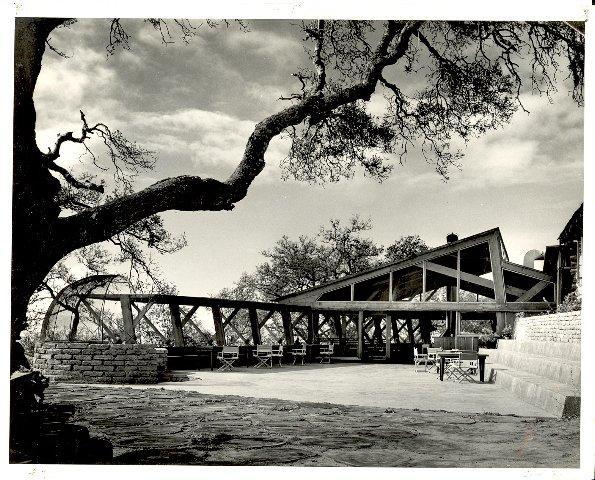Depending on where you sit, on deck or inside at the edge of the world, it can feel like the bow of a boat. Located on the coast of Big Sur, overlooking a breathtaking expanse of the Pacific Ocean, Nepenthe, a restaurant established by Bill and Lolly Fassett in 1949, is a “Valhalla,” characterized in mythology as a place of near-perpetual food, drink, pleasure.
The property was previously owned by Orson Welles and Rita Hayworth, who had married in 1943 and fell in love with the view while their driver, a Mr. Joseph Cotton, was ferrying them from San Francisco to Los Angeles. Four years later, as part of their divorce settlement, the property had gone to “Rita Hayworth Welles,” the name recorded on the deed.
In 1947, the actress sold the 12-acre parcel to the Fassetts, who were looking for a place to live where they could support a family of five children. They paid $14,000 for the property, a lot of money for most folks in 1947.
At the time, the only structure on the property was a log cabin build in 1920s by the Trails Club, who would ride over the Santa Lucias to the south coast. Sam Trotter, a “Paul Bunyon” homebuilder and pioneer of Big Sur, built the cabin as their base of operations. It was Trotter’s sons, Frank and Walker, who eventually built Nepenthe Restaurant 1949 and, later, the Phoenix Shop.
As the Fassett family prepared to celebrate the 75th anniversary of Nepenthe, General Manager Kirk Gafill, a family owner and member of the third generation of Fassetts to take the helm, took some time to talk about the history of this legendary place. Here’s how it all began.
Jane Gallatin married Frank Hubbard Powers, a San Francisco attorney who, with real estate developer James Franklin Devendorf, founded the Carmel Development Company in 1902, through which they established Carmel. The Powers’ daughter, Grace Madeleine, had two daughters, Madeleine (Lolly) and Elizabeth, who were raised in Carmel.
“Prior to marrying my grandfather, Bill Fassett, my grandmother, Lolly, lived for a time on the isle of Capri, where she was very influenced by Old World values and aesthetics,” Gafill said. “My grandfather had gone to Cornell Restaurant & Hotel Management School in New York, yet he and Lolly met in San Francisco in the ‘30s, during the Depression.”
Ultimately, living on the Peninsula, faced with economic challenges and five children to raise, Fassett was looking for entrepreneurial opportunities. He got into publishing with the magazine, “What’s Doing in Carmel,” he worked for SFB Morse at Hotel del Monte, and tried a number of other things, said Fassett, without much success.
“In the search for a place to live where they might be able to support their family,” said Gafill, “it was, perhaps, an odd choice for them to go away from developed areas and down into Big Sur. But my grandmother had visited what became the Nepenthe property as a child and had some notion of it as an adult.”
The qualities of this property are, he says, pretty exceptional, starting with the astonishing south-coast view from an elevation that provides a really remarkable foreground before ever looking out to the horizon. On the coast, where the ocean so big, so expansive, it’s hard to put the view into perspective.
“In most Big Sur properties,” said Gafill, “you’re either looking straight out toward the ocean, or your view is blocked by the nearest ridge. Even if you have a coastal perspective, at 808 feet of elevation, you’re looking south to a 60-mile view. It’s a magical visual that really allows one to appreciate so much of the majesty and remarkable environmental qualities of the Big Sur Coast. Jaws drop for what Mother Nature has provided us.”
Besides, with a southern exposure, temperatures are ambient, and the geography of the coast shelters the property from typical northwesterly winds. This was, says Gafill, a kind of Shangri-la.
Creating a culture
Bill Fassett was working for the Madonna Brothers, doing highway construction to keep his family afloat, when he came up with the idea to build a food-service operation on his property. His first idea was to put a hamburger shack down on the highway level.
“My grandfather met with the County,” said Gafill, “and the County Planner said, ‘Why would you build something on the highway, when you have such beautiful, coastal property? Put it on the hill.’ In 1947, this was well before the Coastal Commission and Big Sur Land Trust that created standards and guidelines for Big Sur.”
Nepenthe restaurant chef Tod Williamson carries a shovel while doing a perimeter check of the property for spillover fires as the Basin Complex Fire burns on the other side of Highway One in Big Sur, Calif. on Thursday July 3, 2008. A small group of locals have decided to stay with their properties and try to defend them as others were told to evacuate. Photo David Royal, Monterey County Herald
Related Articles
Red Lobster files for bankruptcy but will stay open
12 highly anticipated new Bay Area restaurants for summer 2024 and beyond
New California-style restaurant and bar opens in Danville
Gourmet hot dogs, frosé and beer on tap await at this new Martinez restaurant
Mountain View: Pizza champ TonyG will debut new restaurant, plus ‘Apricot Fields’ slices
Fassett reconsidered his plan. Surrounded by a remarkable array of artists and artisans in Big Sur, he went to work to design and build a restaurant overlooking the coast. Rowan Maiden, a former student at UC Berkeley’s School of Architecture, who had trained with Frank Lloyd Wright, designed the restaurant, informed by the notion of blending it in with the nature of the property, and built it with locally milled redwood.
Zev Harris, a Seaside-based artist, who created mosaics and sculpture, came up with the logo for the restaurant and introduced aesthetic contributions that complemented the vision my grandparents had for their restaurant. It was he who introduced the name, “Nepenthe.”
When the Fassetts were considering a name for the restaurant, Harris came up with Nepenthe, “That which surceases from or puts an end to sorrow.” Its source is “The Raven,” by Edgar Allen Poe, which said, “Quaff, oh quaff this kind Nepenthe” or “Come and forget your worldly care.”
“And my grandparents said, ‘That’s it.’ The mythical Phoenix bird, which rises from the ashes, became our logo and symbol,” said Gafill, “so when we later opened our gift shop, we named it the same.”
In 1976, a big oak tree, which had long stood on the Nepenthe deck, died. Sculptor Edmund Kara, a friend of Bill Fassett’s, sculpted a Phoenix out of a piece of redwood, which has been sitting on the side of the highway. He gave it to Lolly Fassett, says Gafill, and installed it, during a grand ceremony, where the oak tree had been and where it remains.
“Before it even opened,” said Gafill, “Architectural Digest featured Nepenthe, as did the German press, creating international notoriety and recognition of the property and drawing people to the Big Sur coast. There were no other comparable guest-serving facilities on the Big Sur coast at the time. There were a few other small places in the Big Sur valley, but nothing with a full bar and expansive views, an aesthetic that appealed to guests from all over the world.”
As they established their restaurant, Bill and Lolly Fassett had a shared notion of the guest experience they sought to create. They understood their guests, who’d stepped away from the hectic nature of their day-to-day lives, would come to this extraordinary place to forget their worldly cares.
Visitors enjoy the view looking south from the back deck of Nepenthe Restaurant in Big Sur, Calif. at sunset. (Photo David Royal — Monterey County Herald file)
“They didn’t want tablecloths and waiters in uniforms, all these things,” said Gafill, “which would create a sense that you had to conform to some standard. They really wanted to celebrate people’s individual personalities, so many of whom were Bohemians and rugged Big Sur characters. But even the Hollywood Glitterati sought this. This mentality fostered a lot of the early decisions of how Nepenthe would present itself.”
From folklore to famous
Nevertheless, Nepenthe’s early days were challenging. By 1949, Highway 1 had been open only a dozen years. The Depression had ended a decade before, but recovery continued. And the war had ended just four years before the Fassetts founded their restaurant.
“Nepenthe became a seasonal business,” Gafill said. “It wasn’t easy to get up or down the coast during the winter, so there just wasn’t enough business to warrant staying open. It became like farming, borrowing funds in the winter, and paying it back in the summer. My grandparents held a costume Bal Masque to close the season on Halloween, and reopened on April 1.”
In 1959, Hearst Castle opened, an event Bill Fassett called “a game changer.” With so many people traveling Highway 1, suddenly Nepenthe picked up business as a welcome way station between San Francisco and San Simeon.
In 1963, the restaurant’s next transformative event, was the filming of “The Sandpiper” movie at Nepenthe. Director Vincente Minnelli, Producer Martin Ransohoff, and the biggest stars of the day: Elizabeth Taylor, Richard Burton, Eva Marie Saint, and Charles Bronson were filming numerous scenes on the property.
“Nepenthe was even built into the script,” said Gafill, “as they incorporated the lifestyle of Big Sur’s Bohemian’s beatniks, and artists into the story. There was folk dancing every evening by dancers from Ojai. My uncle, Kaffe Fassett, an exceptional designer who lives in London, did all the choreography for the movie.”
Because Richard Burton’s UK citizenship meant a limited amount of time he could film in the United States due to tax issues, the film crew built a 3/4 set of Nepenthe in a warehouse in Paris, with a big screen in back, painted to resemble the Pacific Ocean. This, says Gafill, added a whole new, international level of awareness around Nepenthe.
Nepenthe and its setting also lured a parade of famous guests, driving up the coast to enjoy the experience in the absence of paparazzi or intrusive fans. If neighbor Henry Miller wasn’t hanging out at the bar, he was playing ping-pong with Bill Fassett. Steve McQueen and Ali McGraw were regulars at the restaurant, as was Kim Novak, whose home was just up the coast.
Creating commerce
In 1954, about the time Nepenthe opened into a year-round business, Lolly Fassett, who loved to collect curios and antiques, opened The Phoenix Shop on the property which, with its eclectic offering of gifts and collectibles for the mind, body, and spirit, added a whole other level of attraction. It still does.
The two-story Phoenix Shop was originally built with an upper deck and exterior room designed as a caretakers quarters, which has morphed, over the years, into various purposes, including Lolly Fassett’s sewing room and, for one season, a juice bar.
“Once again, for just one season, Dominico Vastarella opened Café Amphora, with a fabulous Mediterranean menu, but a volatile character,” Gafill said. “Looking for a lifestyle change, Bob Wilson, who had Carmel Café in town, took over the lease and introduced more of a brunch menu. His wife, Robin, ran the operation until 1991.”
In 1992, after reroofing the entire building, the Fassett family decided to bring the operations of the café in house, to ensure services were inline with family values.
Percy Sledge (center) performs at Nepenthe in front of the ABC televisions cameras during a filming of the show “Where the Action is” on June 20, 1966. The show produced by Dick Clark, was filmed in Monterey County at Fisherman’s Wharf, the Beach Club in Pebble Beach and Nepenthe. (Monterey Herald Archives)
“Cousin Romney Steele and I, mindful of our grandmother’s influences, brought in market umbrellas and concrete tables, and introduced a very Mediterranean-focused brunch. We named it Café Kevah after our grandfather’s mother, a suffragette. It’s a meaningful touchstone to our grandfather’s side of the family.”
As Kirk Gafill and his family arranged plans to celebrate Nepenthe’s 75th anniversary, Gafill said, “But we never know what our fickle weather or road conditions will be like in April.” On March 30, a large stretch of Highway 1 collapsed and fell into the ocean, effectively blocking travel to and from Big Sur.
“I was thinking more along the lines of heavy rains,” Gafill later said. “but it is part of the tradeoff for living in this spectacular stretch along the Central Coast.”
Nepenthe has remained open to local residents and essential workers, creating a sense of certainty and positive morale among family members and staff. Visitors are once again being allowed in the area via a twice day convoy. Highway 1 is expected to open to signal traffic at the Rocky Creek slip-out on Memorial Day weekend.
“We will look forward to multiple celebratory events throughout the months ahead,” Gafill said, “once Highway 1 reopens.”


